Which Of The Following Is Not Considered To Be An Animal Behavior?
Introduction to Animal Behavior
Behavior is the change in activity of an organism in response to a stimulus and can be grouped every bit innate or learned.
Learning Objectives
Distinguish betwixt innate and learned behaviors
Key Takeaways
Key Points
- Behavioral biological science is the study of the biological and evolutionary bases for changes in activity in response to a stimulus.
- Comparative psychology is an extension of piece of work done in human and behavioral psychology. Ethology is an extension of genetics, evolution, anatomy, physiology, and other biological disciplines.
- Innate behaviors have a strong genetic component and are largely independent of ecology influences; they are "hard wired."
- Learned behaviors result from environmental conditioning; they let an organism to adapt to changes in the environment and are modified by previous experiences..
Key Terms
- behavioral biology: A systematic arroyo to the understanding of human and beast behavior assuming that the behavior of a homo or beast is a result of that individual's history.
- comparative psychology: The scientific report of the behavior and mental processes of not-homo animals, specially as these chronicle to the phylogenetic history, adaptive significance, and development of behavior.
Behavior is the modify in activity of an organism in response to a stimulus. Behavioral biology is the written report of the biological and evolutionary bases for such changes. The idea that behaviors evolved equally a result of the pressures of natural choice is not new.
Animate being beliefs has been studied for decades, by biologists in the science of ethology, by psychologists in the scientific discipline of comparative psychology, and by scientists of many disciplines in the written report of neurobiology. Although at that place is overlap between these disciplines, scientists in these behavioral fields have different approaches. Comparative psychology is an extension of work done in human and behavioral psychology. Ethology is an extension of genetics, evolution, anatomy, physiology, and other biological disciplines. One cannot study behavioral biology without touching on both comparative psychology and ethology.
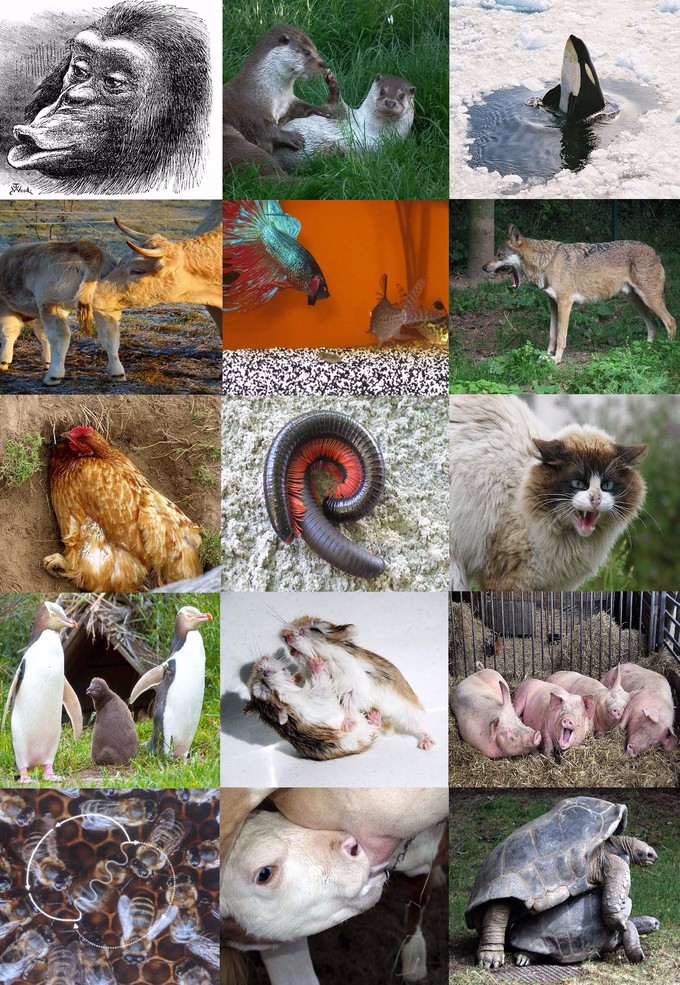
A Range of Fauna Behaviors: Ethology has many aspects ranging from animal communication, emotions, civilization, learning and sexuality.
One goal of behavioral biology is to distinguish the innate behaviors, which have a strong genetic component and are largely contained of environmental influences, from the learned behaviors, which upshot from environmental conditioning.
Innate behavior, or instinct, is important because there is no take chances of an incorrect behavior being learned. These behaviors are "hard wired" into the system. In contrast, learned behaviors are flexible, dynamic, and can be altered relative to changes in the environs. Learned behaviors, even though they may have instinctive components, allow an organism to adapt to changes in the environment and are modified by previous experiences. Simple learned behaviors include habituation and imprinting—both are of import to the maturation process of young animals.
Move and Migration
Innate behaviors, such equally kinesis, taxis, and migration, are instinctual responses to external stimuli.
Learning Objectives
Distinguish between kinesis, taxis, and migration in response to stimuli
Key Takeaways
Fundamental Points
- Innate behaviors are instinctual, relying on responses to stimuli.
- Kinesis is the undirected movement in response to a stimulus, which can include orthokinesis (related to speed) or klinokinesis (related to turning).
- Taxis is the directed movement towards or away from a stimulus, which can be in response to light (phototaxis), chemical signals ( chemotaxis ), or gravity (geotaxis).
- Migration is an innate behavior characterized as the long-range seasonal movement of animals; it is an evolved, adapted response to variation in resource availability.
- Migration is a variable innate behavior as some migrating species ever migrate (obligate migration) while in other animals, only a portion of the population migrates (incomplete migration).
Key Terms
- orthokinesis: the speed of movement of the individual is dependent upon the intensity of the stimulus
- taxis: the movement of an organism in response to a stimulus; like to kinesis, but more direct
- kinesis: the undirected move of an organism in response to an external stimulus
Innate behaviors: motility and migration
Innate or instinctual behaviors rely on response to stimuli. The simplest example of this is a reflex action: an involuntary and rapid response to stimulus. To exam the "human knee-jerk" reflex, a doctor taps the patellar tendon below the kneecap with a safety hammer. The stimulation of the nerves at that place leads to the reflex of extending the leg at the articulatio genus. This is similar to the reaction of someone who touches a hot stove and instinctually pulls his or her paw away. Fifty-fifty humans, with our great capacity to learn, even so exhibit a variety of innate behaviors.
Kinesis and taxis
Another action or motility of innate behavior is kinesis: undirected movement in response to a stimulus. Orthokinesis is the increased or decreased speed of motility of an organism in response to a stimulus. Woodlice, for example, increase their speed of movement when exposed to loftier or depression temperatures. This movement, although random, increases the probability that the insect spends less time in the unfavorable environment. Another example is klinokinesis, an increase in turning behaviors. It is exhibited by bacteria such equally Due east. coli which, in association with orthokinesis, helps the organisms randomly observe a more hospitable environment.
A similar, but more-directed version of kinesis is taxis: the directed movement towards or away from a stimulus. This movement can be in response to light (phototaxis), chemical signals (chemotaxis), or gravity (geotaxis). Information technology tin can be directed toward (positive) or away (negative) from the source of the stimulus. An case of a positive chemotaxis is exhibited by the unicellular protozoan Tetrahymena thermophila. This organism swims using its cilia, at times moving in a straight line and at other times making turns. The alluring chemotactic agent alters the frequency of turning as the organism moves directly toward the source, following the increasing concentration slope.
Migration as innate beliefs
Migration is the long-range seasonal motility of animals. An evolved, adapted response to variation in resource availability, it is a mutual phenomenon found in all major groups of animals. Birds fly south for the winter to go to warmer climates with sufficient food, while salmon migrate to their spawning grounds. The popular 2005 documentary March of the Penguins followed the 62-mile migration of emperor penguins through Antarctica to bring food dorsum to their breeding site and to their young. Wildebeests drift over 1800 miles each yr in search of new grasslands.
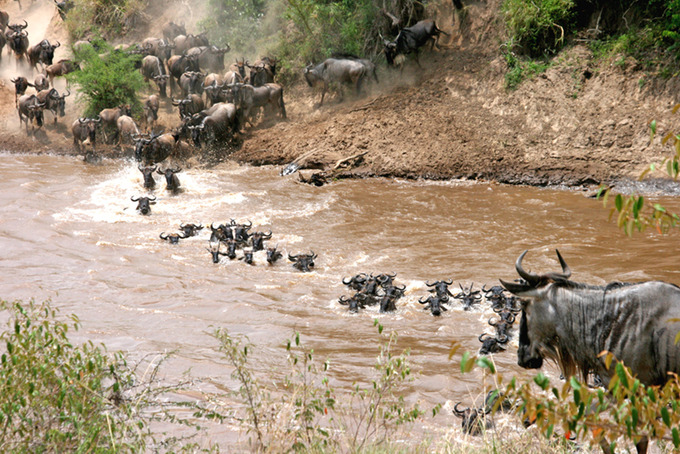
Migration: Wildebeests migrate in a clockwise style over 1800 miles each twelvemonth in search of rain-ripened grass.
Although migration is thought of as an innate behavior, but some migrating species always migrate (obligate migration). Animals that showroom facultative migration can choose to migrate or not. Additionally, in some animals, simply a portion of the population migrates, whereas the rest does not drift (incomplete migration). For example, owls that live in the tundra may migrate in years when their food source, small rodents, is relatively scarce, simply not drift during the years when rodents are plentiful.
Animal Communication and Living in Groups
Animals communicate using signals, which can be chemical (pheromones), aural (sound), visual (courtship displays), or tactile (touch).
Learning Objectives
Differentiate among the ways in which animals communicate
Primal Takeaways
Central Points
- Animals need to communicate with one another in gild to successfully mate, which usually involves ane animal signaling another; the energy-intensive behaviors or displays associated with mating are called mating rituals.
- Animal signaling is not the same as the advice we associate with language, which has been observed only in humans, merely may also occur in some non-man primates and cetaceans.
- Animal communication by stimuli known as signals may be instinctual, learned, or a combination of both.
Key Terms
- pheromone: a chemic secreted past an brute that affects the development or behavior of other members of the aforementioned species, performance frequently as a means of alluring a member of the opposite sex
Innate behaviors: living in groups
Not all animals alive in groups, but even those that live relatively-lonely lives (with the exception of those that tin can reproduce asexually) must mate. Mating usually involves one animal signaling another then as to communicate the desire to mate. At that place are several types of energy-intensive behaviors or displays associated with mating called mating rituals. Other behaviors found in populations that live in groups are described in terms of which animal benefits from the behavior. In selfish beliefs, only the creature in question benefits; in altruistic behavior, one animate being'due south actions benefit another animate being; cooperative beliefs occurs when both animals benefit. All of these behaviors involve some sort of communication between population members.
Communication within a species
Animals communicate with each other using stimuli known as signals. These signals are chemical ( pheromones ), aural (sound), visual (courting and aggressive displays), or tactile (touch on). These types of communication may exist instinctual, learned, or a combination of both. These are not the same as the communication nosotros associate with language, which has been observed only in humans and, possibly, in some species of primates and cetaceans.
A pheromone is a secreted, chemical signal used to obtain a response from another private of the aforementioned species. The purpose of pheromones is to arm-twist a specific behavior from the receiving individual. Pheromones are specially mutual among social insects, but they are used by many animal species to attract the opposite sex, to sound alarms, to mark food trails, and to elicit other, more than-complex behaviors. Even humans are thought to respond to sure pheromones called axillary steroids. These chemicals influence human perception of other people. In one study, they were responsible for a group of women synchronizing their menstrual cycles. The role of pheromones in human being-to-human communication is still somewhat controversial and continues to be researched.
Songs are an example of an aural signal: one that needs to be heard by the recipient. Possibly the best known of these are songs of birds, which place the species and are used to attract mates. Other well-known songs are those of whales, which are of such low frequency that they can travel long distances underwater. Dolphins communicate with each other using a wide variety of vocalizations. Male person crickets make chirping sounds using a specialized organ to concenter a mate, repel other males, and to announce a successful mating.
Courting displays are a series of ritualized visual behaviors (signals) designed to concenter and convince a fellow member of the reverse sex to mate. These displays are ubiquitous in the creature kingdom. They often involve a series of steps, including an initial brandish past one fellow member followed by a response from the other. If at any point the brandish is performed incorrectly or a proper response is not given, the mating ritual is abandoned and the mating attempt will be unsuccessful.

Courting displays: A male peacock's extravagant, eye-spotted tail is used in courtship displays to attract a mate.
Ambitious displays are likewise common in the animal kingdom. Equally, for example, when a dog bares its teeth to go some other dog to dorsum down. Presumably, these displays communicate not simply the willingness of the animate being to fight, but likewise its fighting ability. Although these displays do signal aggression on the role of the sender, it is thought that they are actually a mechanism to reduce the amount of fighting that occurs between members of the same species: they allow individuals to assess the fighting ability of their opponent and thus decide whether it is "worth the fight."
Distraction displays are seen in birds and some fish. They are designed to attract a predator away from the nest that contains their immature. This is an instance of an altruistic behavior: it benefits the young more than the individual performing the display, which is putting itself at risk by doing so.
Many animals, peculiarly primates, communicate with other members in the group through touch. Activities such as preparation, touching the shoulder or root of the tail, embracing, lip contact, and greeting ceremonies have all been observed in the Indian langur, an Old Earth monkey. Similar behaviors are constitute in other primates, especially in the great apes.
Altruism and Populations
Altruistic behaviors may exist explained past the natural instinct to better the chances of passing on one's genes.
Learning Objectives
Explicate how altruistic behaviors tin can benefit populations
Key Takeaways
Central Points
- Behaviors that lower the fettle of the individual, but increment the fitness of another private are termed donating; why altruistic behaviors exist has been the topic of some debate.
- One explanation for donating-blazon behaviors is institute in the genetics of natural pick and the "selfish gene " theory: although a gene cannot be selfish in the human sense, information technology may appear that way if the sacrifice of an individual benefits related individuals that share genes that are identical.
- Fifty-fifty less-related individuals, those with less genetic identity than that shared by parent and offspring, benefit from seemingly-altruistic beliefs, such as sterile worker bees protecting the queen.
- Unrelated individuals may also act altruistically to each other, which seems to defy the "selfish gene" caption; nevertheless, this altruism is typically reciprocal, in that both benefit from the interaction.
- Virtually of the behaviors described when speaking of altruism do non seem to satisfy the definition of "pure" altruism; some evolutionary game theorists advise that we get rid of the terms "altruistic" and "selfish" altogether since they describe homo beliefs.
Key Terms
- kin selection: an evolutionary machinery by which an organism's behavior benefits the reproductive success of its relatives, including at the expense of its own survival or reproduction
- altruism: devotion to the interests of others; brotherly kindness; opposed to egoism or selfishness
- game theory: a branch of applied mathematics that studies strategic situations in which individuals or organizations choose various actions in an attempt to maximize their returns
Altruistic Behaviors
Behaviors that lower the fitness of the individual engaging in the behavior, merely increment the fettle of another private, are termed donating. Examples of such behaviors are seen widely across the animal kingdom. Social insects, such as worker bees, take no ability to reproduce, even so they maintain the queen so she can populate the hive with her offspring. Meerkats continue a spotter continuing guard to warn the rest of the colony nearly intruders, even though the lookout is putting itself at risk. Wolves and wild dogs bring meat to pack members not present during a chase. Lemurs take care of infants unrelated to them. Although on the surface these behaviors appear to be altruistic, it may non be then uncomplicated.
Why Does Altruism Be?
There has been much discussion over why altruistic behaviors exist. Do these behaviors lead to overall evolutionary advantages for their species ? Do they help the altruistic individual laissez passer on its own genes? And what about such activities between unrelated individuals? I explanation for altruistic-type behaviors is found in the genetics of natural pick. In the 1976 book, The Selfish Gene, scientist Richard Dawkins attempted to explain many seemingly-altruistic behaviors from the viewpoint of the gene itself. Although a factor plainly cannot be selfish in the human sense, it may appear that style if the sacrifice of an private benefits related individuals that share genes that are identical by descent (present in relatives because of mutual lineage). Mammal parents make this sacrifice to accept care of their offspring. Emperor penguins migrate miles in harsh weather condition to bring food dorsum for their young. Selfish factor theory has been controversial over the years and is still discussed among scientists in related fields.
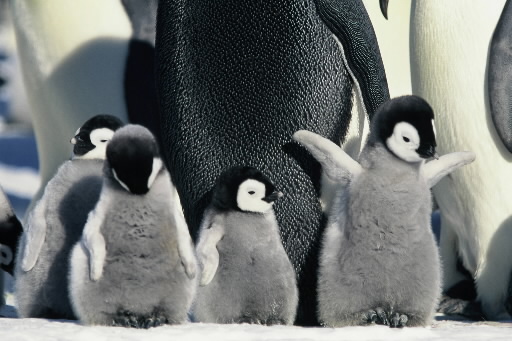
Donating actions: Emperor penguins migrate miles in harsh weather to bring back food for their young. Are farthermost, altruistic deportment such as these motivated by the selfish demand to pass on genes?
Even less-related individuals (those with less genetic identity than that shared by parent and offspring) benefit from seemingly altruistic behavior. The activities of social insects such every bit bees, wasps, ants, and termites are proficient examples. Sterile workers in these societies take care of the queen considering they are closely related to it; as the queen has offspring, she is passing on genes from the workers indirectly. Thus, information technology is of fettle do good for the worker to maintain the queen without having any straight chance of passing on its genes due to its sterility. The lowering of individual fitness to raise the reproductive fitness of a relative and, thus, ane's inclusive fitness evolves through kin selection. This phenomenon can explain many superficially-altruistic behaviors seen in animals. However, these behaviors may non be truly divers every bit altruism in these cases considering the actor is really increasing its own fitness either straight (through its ain offspring) or indirectly (through the inclusive fitness information technology gains through relatives that share genes with it).
Unrelated individuals may also act altruistically to each other; this seems to defy the "selfish gene" caption. An instance of this is observed in many monkey species where a monkey volition present its back to an unrelated monkey to have that individual option the parasites from its fur. Afterward a certain amount of fourth dimension, the roles are reversed and the first monkey at present grooms the second monkey. Thus, there is reciprocity in the behavior. Both benefit from the interaction and their fitness is raised more than if neither cooperated or if one cooperated and the other did not. This behavior is still non necessarily altruism, every bit the "giving" behavior of the actor is based on the expectation that information technology will be the "receiver" of the behavior in the hereafter; a concept termed reciprocal altruism. Reciprocal altruism requires that individuals repeatedly come across each other, oft the result of living in the same social group, and that cheaters (those that never "requite back") are punished.
Evolutionary Game Theory and Altruism
According to evolutionary game theory, a modification of classical game theory in mathematics, many of these and then-called "altruistic behaviors" are not donating at all. The definition of "pure" altruism, based on human beliefs, is an action that benefits another without any direct benefit to oneself. Most of the behaviors previously described practise not seem to satisfy this definition; game theorists are good at finding "selfish" components in them. Others take argued that the terms "selfish" and "altruistic" should exist dropped completely when discussing animal behavior, equally they depict human behavior and may not exist direct applicable to instinctual brute activity. What is clear, though, is that heritable behaviors that improve the chances of passing on one's genes or a portion of 1's genes are favored past natural selection and will be retained in time to come generations every bit long as those behaviors convey a fettle reward.
Mating Systems and Sexual Selection
In mating, at that place are two types of selection (intersexual, intrasexual) and three mating systems (monogamous, polygynous, polyandrous).
Learning Objectives
Differentiate among monogamous, polygynous, and polyandrous mating systems, and distinguish between intersexual and intrasexual mate pick
Key Takeaways
Key Points
- Two types of mate selection occur: intersexual selection (the selection of a mate where individuals of one sex choose mates of the other sex) and intrasexual selection (the competition for mates between species members of the same sex).
- Three general mating systems, all involving innate as opposed to learned behaviors, are seen in beast populations: monogamous ( monogamy ), polygynous ( polygyny ), and polyandrous (polyandry).
- In monogamous systems, 1 male and one female are paired for at least one breeding season; although in some animals, these partnerships can last even longer, sometimes an entire lifetime; males provide substantial parental intendance.
- Polygynous mating refers to one male mating with multiple females; in these situations, the female must be responsible for most of the parental care as the single male is not capable of providing care to that many offspring.
- In polyandrous mating systems, one female mates with many males; these types of systems are much rarer than monogamous and polygynous mating systems.
Fundamental Terms
- polyandry: the mating pattern whereby a female copulates with several males
- polygyny: the mating patterns whereby a male person copulates with several females
- monogamy: a form of sexual bonding involving an exclusive pair bond between ii individuals
Finding Sexual Partners
Not all animals reproduce sexually, but many that do have the aforementioned challenge: they need to find a suitable mate and often have to compete with other individuals to obtain i. Significant free energy is spent in the process of locating, alluring, and mating with a sex partner.
Types of Mate Selection
Two types of pick that occur during the process of choosing a mate may be involved in the evolution of reproductive traits called secondary sexual characteristics. These types are: intersexual choice (the choice of a mate where individuals of one sex choose mates of the other sex) and intrasexual choice (the contest for mates between species members of the same sex). Intersexual selection is often complex because choosing a mate may be based on a diversity of visual, aural, tactile, and chemical cues. An instance of intersexual pick is when female peacocks choose to mate with the male person with the brightest plume. This type of selection often leads to traits in the chosen sex that exercise not raise survival, but are those traits virtually attractive to the opposite sex (often at the expense of survival). Intrasexual selection involves mating displays and ambitious mating rituals such as rams butting heads; the winner of these battles is the one that is able to mate. Many of these rituals use up considerable energy, but result in the selection of the healthiest, strongest, and/or near dominant individuals for mating.
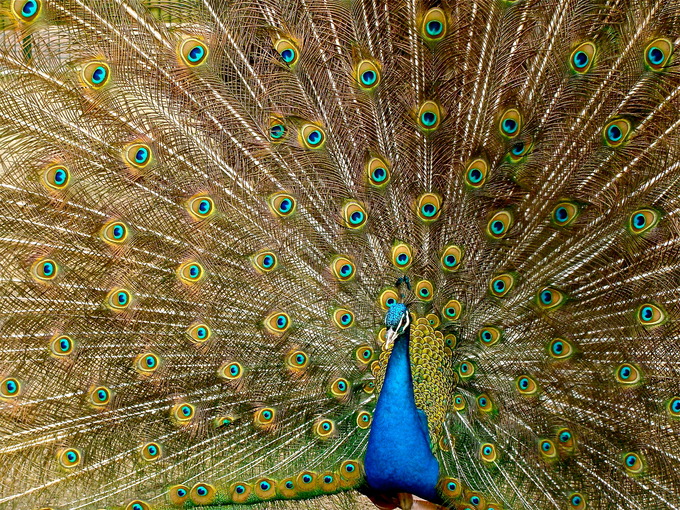
Courtship display of the male peacock: This male peacock's courting display—his intricate, colorful tail feathers—is designed to attract potential mates.
Mating Systems
Three general mating systems, all involving innate equally opposed to learned behaviors, are seen in beast populations: monogamous (monogamy), polygynous (polygyny), and polyandrous (polyandry).
In monogamous systems, one male and one female are paired for at to the lowest degree one breeding season. In some animals, such as the gray wolf, these associations tin last much longer, even a lifetime. Several explanations have been proposed for this type of mating system. The "mate-guarding hypothesis" states that males stay with the female person to prevent other males from mating with her. This behavior is advantageous in such situations where mates are deficient and difficult to find. Some other caption is the "male-aid hypothesis," where males that remain with a female to help guard and rear their young volition have more and healthier offspring. Monogamy is observed in many bird populations where, in improver to the parental care from the female, the male is also a major provider of parental care for the chicks. A third explanation for the evolutionary advantages of monogamy is the "female-enforcement hypothesis." In this scenario, the female ensures that the male does not have other offspring that might compete with her own, and so she actively interferes with the male's signaling to attract other mates.
Polygynous mating refers to i male mating with multiple females. In these situations, the female person must be responsible for nearly of the parental care equally the single male is not capable of providing care to that many offspring. In resourced-based polygyny, males compete for territories with the best resources. They then mate with females that enter the territory, fatigued to its resources richness. The female benefits past mating with a dominant, genetically-fit male; however, it is at the cost of having no male person aid in caring for the offspring. An example is seen in the xanthous-rumped honeyguide, a bird whose males defend beehives considering the females feed on the wax. As the females arroyo, the male person defending the nest will mate with them. Harem mating structures are a type of polygynous system where certain males dominate mating while controlling a territory with resources. Elephant seals, where the alpha male dominates the mating within the group, are an example. A third type of polygyny is a lek organisation. Here there is a communal courtship area where several males perform elaborate displays for females; the females choose their mate from this grouping. This beliefs is observed in several bird species.
In polyandrous mating systems, one female mates with many males. These types of systems are much rarer than monogamous and polygynous mating systems. In pipefishes and seahorses, males receive the eggs from the female person, fertilize them, protect them inside a pouch, and give birth to the offspring. Therefore, the female person is able to provide eggs to several males without the burden of carrying the fertilized eggs.
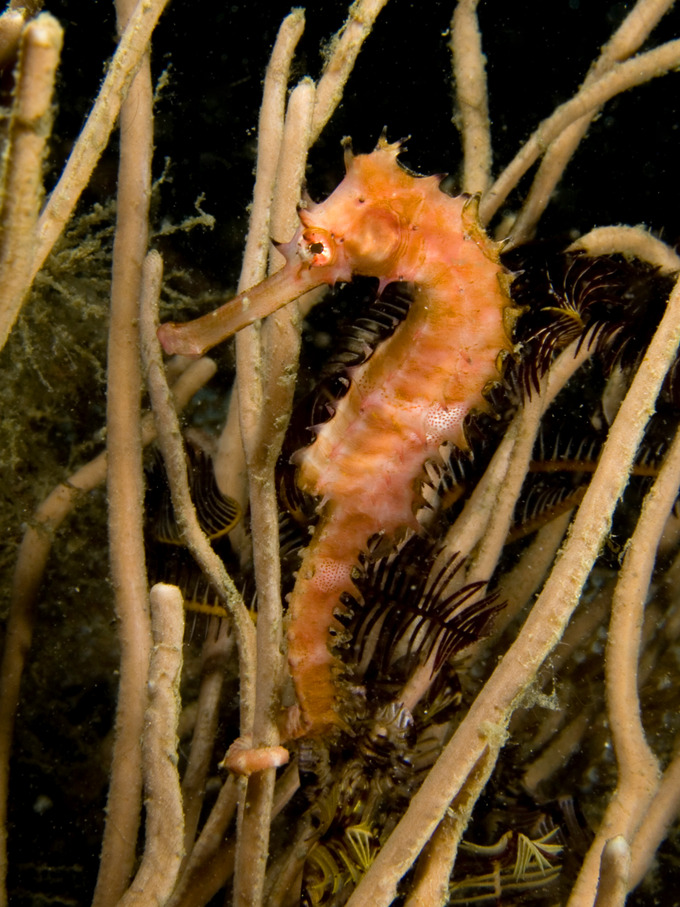
Polyandry: Seahorses are a skilful example of a polyandrous mating arrangement, in which one female person mates with several males. In seahorse reproduction, the male person receives the eggs from the female, fertilizes them, protects them within a pouch, and gives birth to the offspring.
Licenses and Attributions
CC licensed content, Shared previously
- Curation and Revision. Provided by: Boundless.com. License: CC BY-SA: Attribution-ShareAlike
CC licensed content, Specific attribution
- Behavioral Biological science. Provided by: OpenStax CNX. Located at: http://cnx.org/contents/[email protected]:[email protected]/Behavioral-Biology-Proximate-a. License: CC By-SA: Attribution-ShareAlike
- Behaviorism. Provided by: Wikipedia. Located at: https://en.wikipedia.org/wiki/Behaviorism. License: CC BY-SA: Attribution-ShareAlike
- Ethology. Provided past: Wikipedia. Located at: https://en.wikipedia.org/wiki/Ethology. License: CC Past-SA: Attribution-ShareAlike
- Comparative Psychology. Provided by: Wikipedia. Located at: https://en.wikipedia.org/wiki/Comparative_psychology. License: CC By-SA: Attribution-ShareAlike
- Ethology_diversity.jpg. Provided by: Wikipedia. Located at: https://commons.wikimedia.org/wiki/File:Ethology_diversity.jpg. License: CC By-SA: Attribution-ShareAlike
- OpenStax College, Biology. October 17, 2013. Provided by: OpenStax CNX. Located at: http://cnx.org/content/m44879/latest/?collection=col11448/latest. License: CC BY: Attribution
- taxis. Provided by: Wiktionary. Located at: http://en.wiktionary.org/wiki/taxis. License: CC Past-SA: Attribution-ShareAlike
- orthokinesis. Provided by: Wikipedia. Located at: http://en.wikipedia.org/wiki/orthokinesis. License: CC Past-SA: Attribution-ShareAlike
- kinesis. Provided past: Wiktionary. Located at: http://en.wiktionary.org/wiki/kinesis. License: CC By-SA: Attribution-ShareAlike
- Ethology_diversity.jpg. Provided by: Wikipedia. Located at: https://commons.wikimedia.org/wiki/File:Ethology_diversity.jpg. License: CC BY-SA: Attribution-ShareAlike
- OpenStax College, Behavioral Biology: Proximate and Ultimate Causes of Beliefs. October 17, 2013. Provided by: OpenStax CNX. Located at: http://cnx.org/content/m44879/latest/Figure_45_07_02.jpg. License: CC BY: Attribution
- OpenStax Higher, Biological science. Oct 17, 2013. Provided by: OpenStax CNX. Located at: http://cnx.org/content/m44879/latest/?collection=col11448/latest. License: CC By: Attribution
- pheromone. Provided past: Wiktionary. Located at: http://en.wiktionary.org/wiki/pheromone. License: CC BY-SA: Attribution-ShareAlike
- Ethology_diversity.jpg. Provided by: Wikipedia. Located at: https://commons.wikimedia.org/wiki/File:Ethology_diversity.jpg. License: CC BY-SA: Attribution-ShareAlike
- OpenStax College, Behavioral Biological science: Proximate and Ultimate Causes of Beliefs. October 17, 2013. Provided by: OpenStax CNX. Located at: http://cnx.org/content/m44879/latest/Figure_45_07_02.jpg. License: CC BY: Attribution
- Provided by: http://www.soil-net.com/album/Animals/Birds/slides/Peacock%252004.jpg. Located at: http://world wide web.soil-cyberspace.com/album/Animals/Birds/slides/Peacock%2004.jpg. License: CC Past: Attribution
- OpenStax College, Biological science. October 17, 2013. Provided by: OpenStax CNX. Located at: http://cnx.org/content/m44879/latest/?collection=col11448/latest. License: CC By: Attribution
- altruism. Provided by: Wiktionary. Located at: http://en.wiktionary.org/wiki/altruism. License: CC BY-SA: Attribution-ShareAlike
- game theory. Provided by: Wiktionary. Located at: http://en.wiktionary.org/wiki/game_theory. License: CC BY-SA: Attribution-ShareAlike
- Ethology_diversity.jpg. Provided by: Wikipedia. Located at: https://commons.wikimedia.org/wiki/File:Ethology_diversity.jpg. License: CC BY-SA: Attribution-ShareAlike
- OpenStax College, Behavioral Biological science: Proximate and Ultimate Causes of Behavior. October 17, 2013. Provided past: OpenStax CNX. Located at: http://cnx.org/content/m44879/latest/Figure_45_07_02.jpg. License: CC By: Attribution
- Provided by: http://www.soil-internet.com/album/Animals/Birds/slides/Peacock%252004.jpg. Located at: http://www.soil-net.com/album/Animals/Birds/slides/Peacock%2004.jpg. License: CC Past: Attribution
- Provided by: Boston.com. Located at: http://www.boston.com/lifestyle/green/greenblog/pe.jpg. License: CC BY-SA: Attribution-ShareAlike
- OpenStax College, Biology. Oct 17, 2013. Provided by: OpenStax CNX. Located at: http://cnx.org/content/m44879/latest/?drove=col11448/latest. License: CC Past: Attribution
- polygyny. Provided by: Wiktionary. Located at: http://en.wiktionary.org/wiki/polygyny. License: CC BY-SA: Attribution-ShareAlike
- polyandry. Provided by: Wiktionary. Located at: http://en.wiktionary.org/wiki/polyandry. License: CC By-SA: Attribution-ShareAlike
- monogamy. Provided by: Wiktionary. Located at: http://en.wiktionary.org/wiki/monogamy. License: CC By-SA: Attribution-ShareAlike
- Ethology_diversity.jpg. Provided by: Wikipedia. Located at: https://eatables.wikimedia.org/wiki/File:Ethology_diversity.jpg. License: CC BY-SA: Attribution-ShareAlike
- OpenStax Higher, Behavioral Biology: Proximate and Ultimate Causes of Beliefs. October 17, 2013. Provided by: OpenStax CNX. Located at: http://cnx.org/content/m44879/latest/Figure_45_07_02.jpg. License: CC BY: Attribution
- Provided past: http://www.soil-net.com/album/Animals/Birds/slides/Peacock%252004.jpg. Located at: http://www.soil-net.com/album/Animals/Birds/slides/Peacock%2004.jpg. License: CC BY: Attribution
- Provided past: Boston.com. Located at: http://www.boston.com/lifestyle/green/greenblog/pe.jpg. License: CC Past-SA: Attribution-ShareAlike
- Paonroue.JPG. Provided by: Wikimedia. Located at: https://commons.wikimedia.org/wiki/File:Paonroue.JPG. License: CC BY-SA: Attribution-ShareAlike
- Hippocampus hystrix (Spiny seahorse). Provided by: Wikimedia. Located at: http://eatables.wikimedia.org/wiki/File:Hippocampus_hystrix_(Spiny_seahorse).jpg. License: CC BY-SA: Attribution-ShareAlike
Source: https://courses.lumenlearning.com/boundless-biology/chapter/innate-animal-behavior/
Posted by: brumfieldgince1938.blogspot.com

0 Response to "Which Of The Following Is Not Considered To Be An Animal Behavior?"
Post a Comment